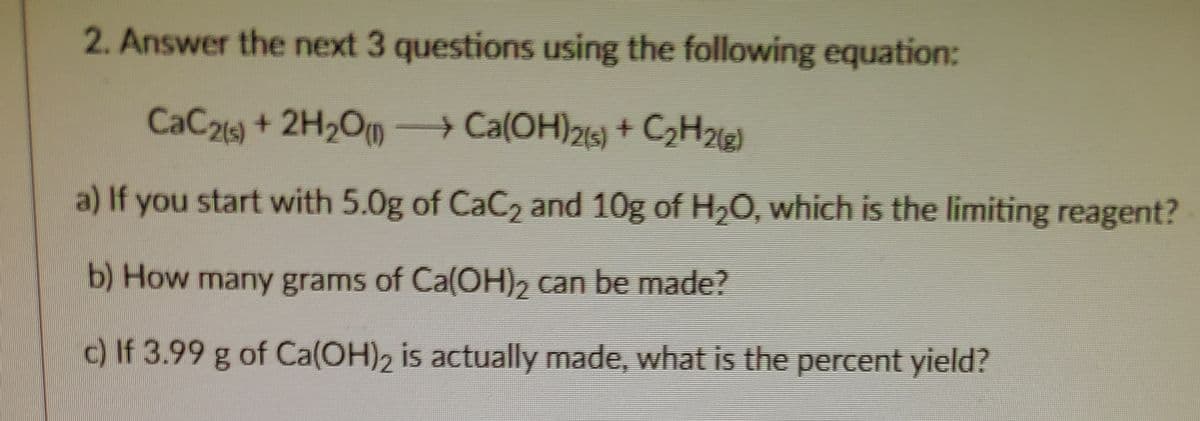2. Answer the next 3 questions using the following equation: CaC2t) + 2H2Om → Ca(OH)25) + C,H2ie) a) If you start with 5.0g of CaC2 and 10g of H2O, which is the limiting reagent? b) How many grams of Ca(OH))2 can be made? c) If 3.99 g of Ca(OH)2 is actually made, what is the percent yield?
2. Answer the next 3 questions using the following equation: CaC2t) + 2H2Om → Ca(OH)25) + C,H2ie) a) If you start with 5.0g of CaC2 and 10g of H2O, which is the limiting reagent? b) How many grams of Ca(OH))2 can be made? c) If 3.99 g of Ca(OH)2 is actually made, what is the percent yield?
Chemistry for Engineering Students
4th Edition
ISBN:9781337398909
Author:Lawrence S. Brown, Tom Holme
Publisher:Lawrence S. Brown, Tom Holme
Chapter4: Stoichiometry
Section: Chapter Questions
Problem 4.61PAE: 4.61 What is actually measured by the octane ratings of different grades of gasoline?
Related questions
Question

Transcribed Image Text:2. Answer the next 3 questions using the following equation:
CaC21) +2H2Om
Ca(OH)21) + C2H2e)
-
a) If you start with 5.0g of CaC2 and 10g of H20, which is the limiting reagent?
b) How many grams of Ca(OH), can be made?
c) If 3.99 g of Ca(OH)2 is actually made, what is the percent yield?
Expert Solution
This question has been solved!
Explore an expertly crafted, step-by-step solution for a thorough understanding of key concepts.
This is a popular solution!
Trending now
This is a popular solution!
Step by step
Solved in 4 steps

Knowledge Booster
Learn more about
Need a deep-dive on the concept behind this application? Look no further. Learn more about this topic, chemistry and related others by exploring similar questions and additional content below.Recommended textbooks for you

Chemistry for Engineering Students
Chemistry
ISBN:
9781337398909
Author:
Lawrence S. Brown, Tom Holme
Publisher:
Cengage Learning

Chemistry for Engineering Students
Chemistry
ISBN:
9781337398909
Author:
Lawrence S. Brown, Tom Holme
Publisher:
Cengage Learning